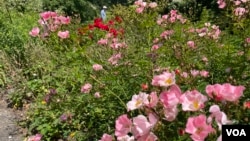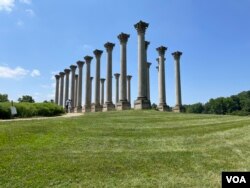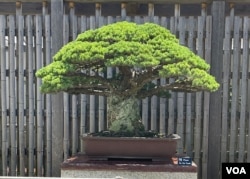Nestled among Washington’s busy streets is a sprawling garden oasis that many Americans have never heard of.
From the vibrant flowers in the azalea collection, to a field of native ferns and the blooming trees in the dogwood section, the U.S. National Arboretum offers the serene natural beauty of a public garden. But government scientists in charge of the 452-acre (183-hectare) complex have a top-priority mission: shore up the U.S. economy by making sure that this critical type of agriculture continues to thrive.
“What we do is support the American nursery industry … which is really one of the largest forms of agriculture,” says Richard Olsen, director of the National Arboretum. “You have ornamental landscapes, horticulture, turf — all of that occurs in every county, in every state of the union. So, it forms a large portion of American agriculture and therefore, an important part of the economy.”
The ornamental and landscape plant industry generates $13.8 billion in sales each year, according to the most recent figures from the U.S. Department of Agriculture. Established by Congress in 1927, the arboretum plays a leading role in researching and developing trees, shrubs, flowers and grass, with a particular focus on woody landscape plants like trees and bushes.
“We are, first and foremost, a premier scientific institution, science-based research facility and public garden,” Olsen says. “It's somewhere around 650-plus plants that we have bred or released. … [including] more than 450 azaleas for American landscapes. But they include maples, viburnums, lilacs, camelias, American elms, hemlocks. … We’ve released quite a few across the board, usually out of our breeding programs [since 1927].”
The arboretum is home to one of the largest collections of preserved seeds in the world. The National Arboretum Herbarium houses around 700,000 specimens, including those from species that the U.S. Department of Agriculture views as economically important.
“One of the things that we focus on is collecting the genetic diversity within those species, and both native and non-native. So, our role, our goal and our mission is to conserve as much of the genetic diversity of those species as possible,” says Kevin Conrad, the arboretum’s lead horticulturist.
The reason for collecting that data is to protect plants from adverse situations such as climate change, altered habitats and other new and potential risks.
“We never know what the emerging threat will be. There is a chance that a gene from any of those collections would help resolve that issue,” Conrad says. “There are examples throughout the USDA history, in conservation and plant collection, where the gene in a wheat plant or a grape plant has been able to thwart a disaster, a catastrophic event, a collapse of a critically important agricultural crop.”
While the scientists do their work, the public is free to roam the arboretum grounds. About 600,000 people visit the gardens each year. That’s a fraction, for example, of the 25 million who visit the National Mall, which is a much better-known Washington attraction.
One of the highlights for visitors are the original columns from the east portico of the United States Capitol building. The exact site for the columns, which were installed at the arboretum in 1990, was selected by Russell Page, a leading landscape architect of his time.
“They’re pretty iconic here,” Olsen says. “They were the originals from around the 1820s to the Eisenhower administration, the 1950s. So, every president from Andrew Jackson to [Dwight] Eisenhower was inaugurated on those columns.”
Another big draw is the Bonsai Museum, which houses 53 bonsai trees that Japan gifted to the United States for its bicentennial in 1976. The collection includes a centuries-old Yamaki pine tree that survived the U.S. bombing of the Japanese city of Hiroshima in 1945.
“It was up against the wall, and the blast went up and over the wall, and the tree survived,” Conrad says. “You know, planting a tree is something you can do for generations to come. The Yamaki pine is a symbol of that.”
Although many people, even the most ardent gardener, might not know it, the arboretum has had a hand in developing many of the trees, flowers, shrubs, turf and other plants that adorn front yards across the United States.
“The ultimate goal really is to green the landscape,” Conrad says. “It’s to create a welcoming, secure, safe, beautiful, calming landscape for the public.”











